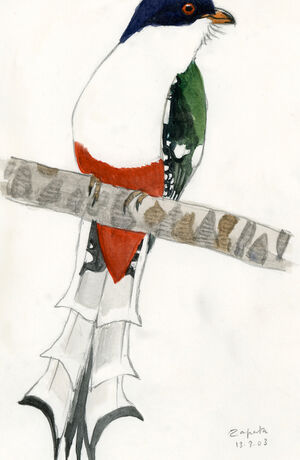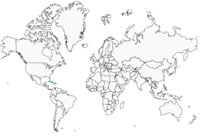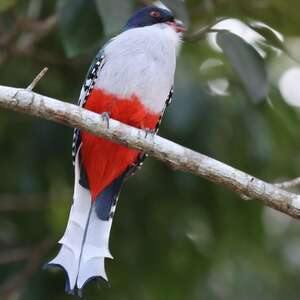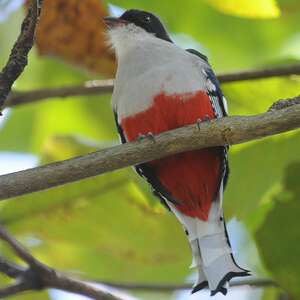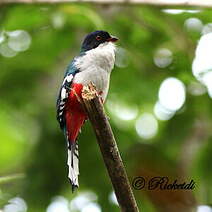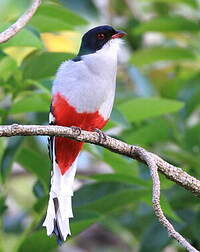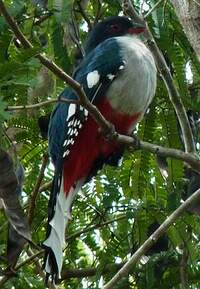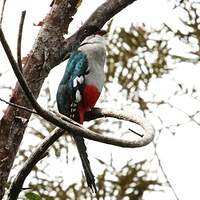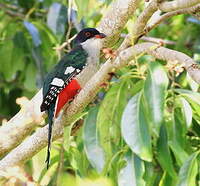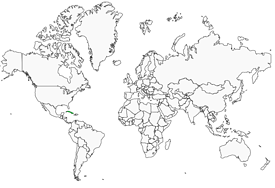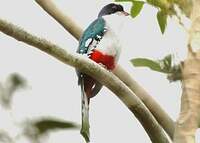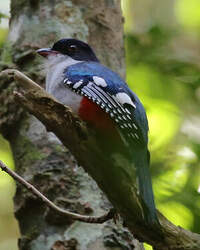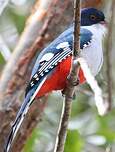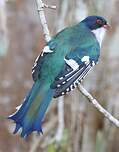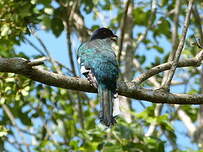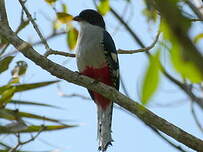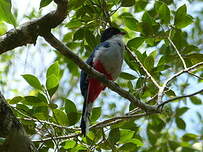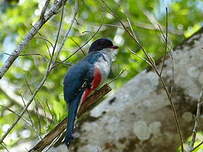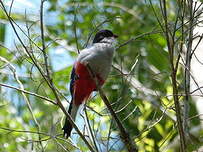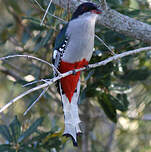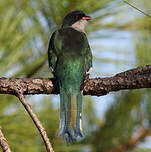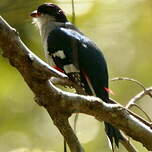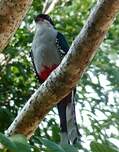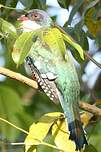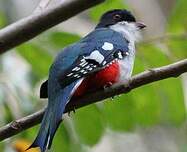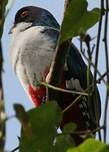Cuban Trogon
Priotelus temnurus - Trogon de Cuba
Identification
The Cuban Trogon is, like all trogons, a multi-coloured bird, but to find a bird with the colours of the resident country, blue-white-red, is rarer! Priotelus temnurus is the national bird of Cuba and our Hispanic friends have found a more romantic name: Trogon tocororo, in homage to its song. Measuring 25 cm, the dimorphism is less marked, the Cuban Trogon has the forehead, the cap and the neck dark blue with violet reflections, the parotiques are black and a fairly thick black loreal line connects the red eye to a very beautiful also red beak, the upper mandible being clearly coloured in black. A characteristic of the species is the presence of very fine white-grey feathers behind the eye, the throat is white and the feathers of this latter being a little longer, giving a hirsute air to the bird when there is wind. The chest becomes white-gray with a slightly downy aspect, a very fine white band separates the chest from the vermilion belly. The mantle, back and rump are green with deep bronzy reflections, with a certain light the bird appears golden or copper on the back. The scapulars have the same colour, sometimes more marked with bronze shades, the medium coverts dark green have white ends, the large coverts also have this green colour with a thin dark blue edging at its tips, the extremities of these coverts being white. The alula is marked with long white and black stripes while the primary coverts are white with black tips. The primary remiges are marked vertically with long white stripes with black edges, the lower part of these remiges as well as the secondaries being barred with wide black horizontal marks. The wing and tertiaries are black, spotted with some white marks at the base of the latter.The tail is exceptional in its shape and colours: divided into three parts like a pair of scissors cut drapery or the wings of a kite, the lower rectrices are white with a black tip, while the upper rectrices have the colours of a rainbow, violet blue on the outer feathers to become bright green in the center and finally end in golden copper in its center. The Cuban Trogon being quite friendly and always perched, will therefore show its extraordinary tail both from the front and from the back! The female is slightly smaller with a slightly paler belly than her companion. The tarses are dark brown and hardly visible. The juveniles are paler than their parents, the head is green and does not yet have the blue colouration, the coverings are greener and less marked with black and white spots, and the bright red of the parents will only appear later, the tail is less cut and the lower rectrices are pale pink rather than white. Two ssp are recognized: Priotelus temnurus temnurus which is the nominal race, present throughout the island of Cuba, and ssp Priotelus temnurus vescus exclusive to the island of Los Pinos in the southwest of Cuba, of smaller size, with pale red belly and stronger beak.
Subspecific information 2 subspecies
- Priotelus temnurus temnurus (Cuba)
- Priotelus temnurus vescus (Isle of Pines)
Foreign names
- Trogon de Cuba,
- Trogón tocororo,
- surucuá-cubano,
- Kubatrogon,
- kubai trogon,
- Cubaanse Trogon,
- Trogone di Cuba,
- kubatrogon,
- Kvasthaletrogon,
- tokororo dôverčivý,
- trogon kubánský,
- Cubatrogon,
- kuubantrogoni,
- trogon de Cuba,
- pilik czerwonodzioby,
- Кубинский трогон,
- キューバキヌバネドリ,
- 古巴咬鹃,
- 古巴咬鵑,
Voice song and cries
Habitat
Dietfeeding habits
Reproduction nesting
Threats - protection
IUCN conservation status
concern
in the Wild
threatened
evaluated
The Cuban Trogon (Trogon de Cuba) is probably less in danger than its cousin, the White-necked Jacobin (Trogon damoiseau) on the neighbouring island of Haiti and the Dominican Republic. However, the subspecies, Priotelus temnurus vescus, seems to be decreasing on L'Isle des Pins.
Sources of information
- IOC World Bird List (v14.1), Gill, F and D Donsker (Eds). 2023.
- A Natural history of the Trogonidae, Joseph M.Forshaw Albert Earl Gilbert
- Vol. 6 - Handbook of the Birds of the World, Josep del Hoyo-Andrew Elliott-Jordi Sargatal
- xeno-canto, Sharing bird sounds from around the world,
- Arthur Grosset's Birds, Arthur Grosset
- Avibase, Lepage Denis
- BirdLife International, BirdLife International
- Wikipédia, Wikipedia, The Free Encyclopedia
Other sources of interest
 Specification sheet created on
30/07/2023 by Anne et Gabriel Leboff
Specification sheet created on
30/07/2023 by Anne et Gabriel LeboffTranslation by AI Oiseaux.net
published: 23-06-2013 - Updated: 10-09-2013
© 1996-2024 Oiseaux.net
- Accipitriformes
- Aegotheliformes
- Anseriformes
- Apodiformes
- Apterygiformes
- Bucerotiformes
- Caprimulgiformes
- Cariamiformes
- Casuariiformes
- Charadriiformes
- Ciconiiformes
- Coliiformes
- Columbiformes
- Coraciiformes
- Cuculiformes
- Eurypygiformes
- Falconiformes
- Galliformes
- Gaviiformes
- Gruiformes
- Leptosomiformes
- Mesitornithiformes
- Musophagiformes
- Nyctibiiformes
- Opisthocomiformes
- Otidiformes
- Passeriformes
- Pelecaniformes
- Phaethontiformes
- Phoenicopteriformes
- Piciformes
- Podargiformes
- Podicipediformes
- Procellariiformes
- Psittaciformes
- Pterocliformes
- Rheiformes
- Sphenisciformes
- Steatornithiformes
- Strigiformes
- Struthioniformes
- Suliformes
- Tinamiformes
- Trogoniformes

